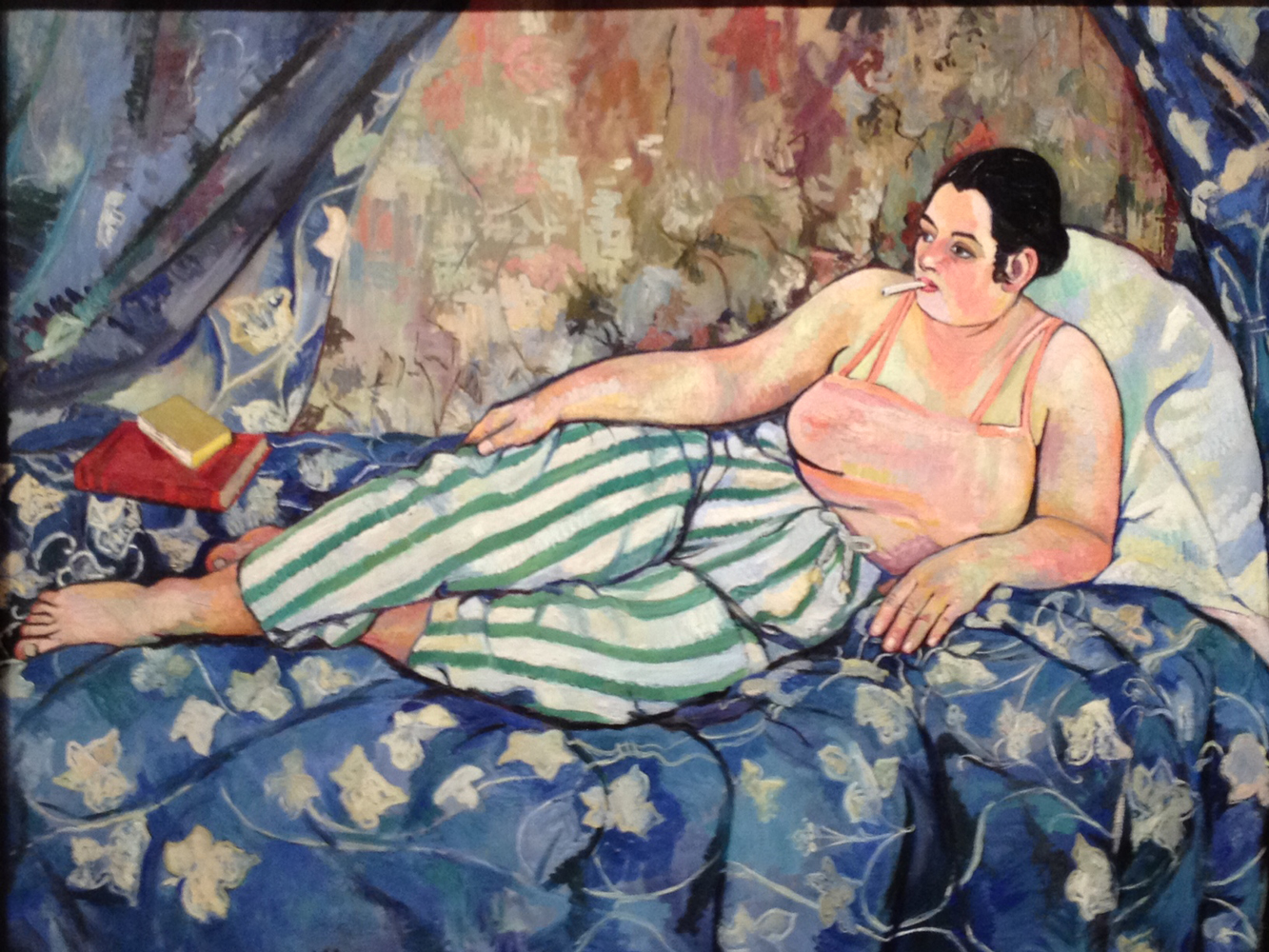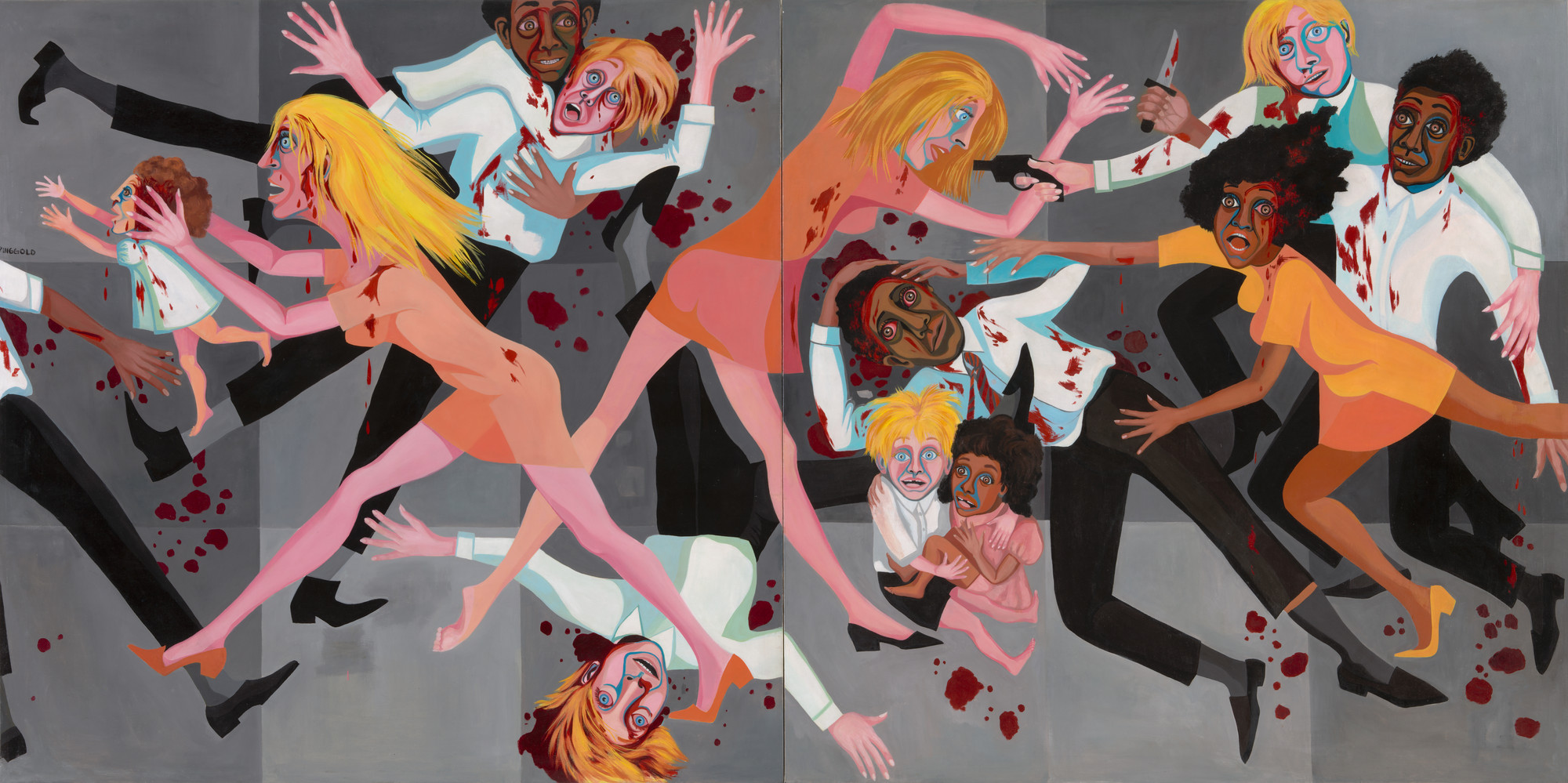Modernism indicates the beginning of the concept of
abstraction, which had been previously less explored, and the infusion with nature and
spiritual context. During this time we see artists involving themselves with
the visual language, decorative arts in textiles, and a change in painting
styles pertaining to abstraction. The
new techniques being applied by women artists influenced modernity, the use of
geometric figures in clothing lead to the emergence of fashion. Modernism was not only about the new fashion
trends, such as the abandoning of the corset, but also about the development of
the visual language in abstraction. It was the time for the merging of the fine
arts and ornamental crafts, which was not seen as true art in previous time
periods. The abstract tendencies of
modernism and ornamentation focused around the meaning of symbolism and inner significance. One of the artists that influenced many others to the move toward abstraction was Wassily Kandinsky, who arrived during the Munich period in 1896. His style revolved around the ornamental and decorative, which influenced Peg Weiss's work in the Reform Dress Movement. As mentioned previously, one of the main movements of modernism was the reforming of the women's dress, the whalebone stays, bustles and tight lacings were replaced because of the physical trouble it caused women (Chadwick 254). Instead, a new redesign took place to accommodate the flexible curvature of the modern woman's body. Shifting into the art of paintings, modernism indicated a new style of art, artists such as Gabrielle Münter explored the new techniques of painting. In her work "Portrait of Marianne von Werekfin 1909" she uses multicolors simplified into blocks, and a striking gold background, pyramidal forms and the very thick black outline, which was characteristic of her unique work. Münter had a particular interest in the bold patterns and planar simplification, this was popular in Modernism flatness was still part of painting. Another popular work of Münter that emphasizes the ideas and concepts of modernism is illustrated by one of her paintings "Boating 1910", in this painting the landscape is projected as being flat, although in past time periods such landscapes were also portrayed as having a sense of depth, but in Modernism it was different. Characteristics of Modern painting were flat and simplified space, singular color blocks and most importantly a big relationship to colors.
.jpeg?1375522125) |
| Gabrielle Münter "Portrait of Marianne von Werekfin, 1909" Painting style focused on colors and heavy outline, plane surface. |
Sonia Delaunay's work consisted of both painting and decoration, her work with textiles and embroidery encouraged her emphasize surface structure being combined (Chadwick, 261). She began making dresses with simultaneous patterns, they were designed to enhance the female's body and its natural movements, color patterns were exclusively important.
Delaunay produced two-dimensional geometric patterns, she integrated both painting and decoration which influenced the movement toward modernity and the language of abstraction. By wearing the geometric abstraction, the consumer becomes a personification of modernity. During the Dada movement, there is a switch from traditional painting. sometimes unable to communicate the vitality of modern life, and this change is the introduction of the clothing for women to allow them to communicate and express themselves as constantly undergoing transformation (Chadwick, 274). It was thanks to artists like Delaunay that economic and cultural changes took place, the commodification of women and their roles as consumers liberated them and gave them a new identity. It provided women independent power to purchase/consume. In addition, a popular modern style of painting was the illustration of separate pieces sawn together in a contrast, as well as translucence as part of abstract painting.
 |
| Sonia Delaunay, "Simultaneous contrasts, 1913" Popular for her geometric forms representing the abstraction in modernism. |
Hannah Höch and Romaine Brooks
 |
| Marlene Dietrich in the movie Morocco, 1930. Representation of the modern woman |
Dadaists shared their commitment to break apart from the traditional static painting style, and integrated the concept of abstraction. In DADA- Dance, 1919-21, we see Höch's work experimenting with the use of collage elements, the mass production of images and fusing them together gives them new meaning and it emphasizes the subject. One of the controversial works of Höch is the character played by Marlene in a scene, the scene is very significative of change and the traveling into modernity. This female character is seen wearing pants, masculine clothes, and smoking cigarettes, which becomes a statement and political movement. These things portrayed are seen as women challenging the rules being imposed on them and accepting the era of modernity.
Romaine Brooks was also a very important icon of modernity particularly in times of androgyny, this was the end of the corsets and feminine clothing, and we see the emergence of masculinized female clothing and cross genders. She served to destabilize the categories of masculinity and femininity and was a powerful force for the modern women. (Chadwick, 297)
 |
| Romaine Brooks, Self Portrait 1966 |
Modernist Representation of the female body
During modernism, some artists challenged the male gaze, the idea that female nudes are available for male pleasure. Paula Modersohn-Becker and Suzanne Valadon challenge the male gaze by portraying nudes, which do not hold the same meaning they used to prior to this period. Paula Modersohn illustrates female nudes through connections to nature and emotions, the nude form is not there as fetish for men, instead it represents emotions.
 |
| Paula Modersohn-Becker, Self portrait with Amber Necklace 1906. Projects the female nude body in connection to nature and emotions. The female is not in display for the male gaze. |
Similarly, Suzanne Valadon projects the meaning of natural womanhood, her nudes integrate observation with anatomical knowledge of the female body. In one of her famous works "Grandmother and Young girl Stepping into the Bath, 1908" She presents the female body in its awkward gestures of figures, which indicates that the female has full control of her body, she is not being forced to be there compared to popular male gaze art work. These works are different from nudes presented by Berger, another work by Valadon "The blue room, 1923" also shows the difference between pervasive male gaze versus modern females in painting. The woman in the painting is thicker, she is also smoking, which symbolizes independency and the breaking of taboos. The painting also shows books, an example of empowerment. These are examples of how modernity has changed the meaning of females in painting, and how women in modern nudes are not portrayed for the pleasure of males, and they own themselves and their bodies.
Surrealism is also an approach in modern art used as instrument by known artists such as Frida Kahlo, who identified herself and her body with forces of nature. (Chadwick, 289)
 |
| Suzanne Valadon, "Grandmother and Young girl Stepping into the Bath, 1908" |
 |
| Suzanne Valadon, "The blue room, 1923" |
Post-modernism
 |
| Maria Montoya Martinez, "Black-on-Black ceramic, 1939" The beginning of post-modernism, focusing on ancestry and symbolic art |
Modernism period was about switching from traditional and static painting to a more abstract geometric meaning of art and craft. As well as the transitioning to a more liberal modern woman growing as a consumer and example of empowerment and independency. Post-modernism, in contrast, left from geometric abstract painting to symbolic imagery. We see different artists focusing on the symbolic meaning of their art attributed to their roots and their identity or ancestry. (Chadwick, 319). Artists such as Maria Montoya Martinez, left the geometric abstraction art to transition into pottery, which was very different to the usual modernism textiles and clothing from geometric figures. She was looking into indigenous, cultural crafts and styles that had symbolic meaning such as fertility, rivers, environment etc.
Other artists such as Betye Saar also look into their identity and ancestry, one of her works "The liberation of Aunt Jemima, 1972" was more of a political movement that also involved identity because of the white culture's stereotypical images of women of color and their roles (Chadwick, 342). In this craft we are able to see Aunt Jemima fulfilling the roles of cleaning, taking care of a child, holding a broom, but we also see her holding a rifle, which gives her power. She is liberated from the exploitation by giving her the rifle, but it is important to recognize that it is not an incentive to violence, instead, it is raising awareness and empowerment. Lastly, a painting from artist Faith Ringgold "Die 1967" is a very important example of post-modernism. As we see in Aunt Jemima example, we are dealing with a time period of racial segregation and violence, through her work, faith is exploring the ideas about race and violence on the streets.
 |
| Faith Ringgold, "Die 1967" A different phase of post-modernism |
Post-modernism explores different concepts and ideas. Modernism focuses on the transition to a new period where women start becoming consumers and giving rise to the Dress Reform, as well as the emergence of geometric patterns and abstract images. It also focuses on exploring the difference of modern nudes compared to the typical male gaze nudes, women are controlling their own bodies and emotions. Post-Modernism, on the other hand, revolves around the ideas of indigenous and ancestral art that define the artists identity, and also studies the ideas of racial segregation and violence. Therefore, both periods of time focus on different fields.
Work Cited:
Chadwick, Whitney. Women, Art, and Society. 4th ed. New York, N.Y.: Thames and Hudson, 1990. Print.
The Guerrilla Girls' Bedside Companion to the History of Western Art. New York: Penguin, 1998. Print.
Work Cited:
Chadwick, Whitney. Women, Art, and Society. 4th ed. New York, N.Y.: Thames and Hudson, 1990. Print.
The Guerrilla Girls' Bedside Companion to the History of Western Art. New York: Penguin, 1998. Print.

No comments:
Post a Comment